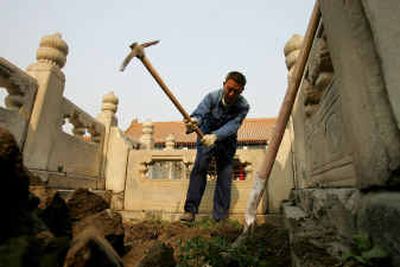China restoring its centuries-old imperial palace

BEIJING – China plans to tear down a museum to restore the original appearance of its imperial palace in a sweeping renovation of the Forbidden City that will last until 2020, officials said this week.
The towers and gates of the 600-year-old palace, where 24 emperors lived in central Beijing, are shrouded in construction scaffolding as hundreds of workers repair, repaint and retile them.
The planned work, under way since 2001, calls for restoring and rebuilding villas and gardens, some of which have been untouched for more than a century, said Jin Honghui, the palace’s deputy curator.
“Our aim is to ensure the integrity and historical truth of the Forbidden City,” Jin said at a news conference held Thursday in a former imperial parlor at the vermillion walled palace.
The Forbidden City, completed in 1420 during the Ming Dynasty, is the world’s biggest palace. Despite decades of neglect, it is considered the biggest and best preserved specimen of classical Chinese architecture.
The renovation is costing $12 million a year, according to Jin. The work right now involves 1,400 carpenters, bricklayers and engineers.
Officials plan to remove several modern structures that disrupt the traditional setting, including the National Archives Museum, Jin said.
“It has nothing to do with the palace,” he said.
The museum is to be demolished and its collection moved to a new facility.
The palace is so dilapidated after a century of war, fires and political upheaval that most of its 8,000 rooms are closed to the public.
But still, the Forbidden City is China’s top tourist attraction, drawing some 7 million visitors a year. The repair work already has consumed 330,000 bricks, and 590,000 glazed tiles for the palace’s mustard yellow rooftops.
Technicians also are rebuilding furniture, restoring woodwork, and repainting neatly decorated eaves, some of which are more than five centuries old.
The restorers also are rebuilding the Jianfugong Garden, which was destroyed by fire in 1923, Jin said.